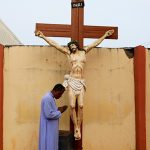The Trump administration is playing a key role in winding down conflicts throughout the Middle East. However, high-level engagement is also fraught with risks.
The United States is playing an increasingly significant role in several countries in the region. In several cases, the White House is also trying to guide countries and regions to stability. From Syria to Gaza, this has the potential to transform the Middle East. However, this strategy could draw the United States into a number of crises at a time when the White House has sought to focus on either domestic policy or larger issues in Asia and Europe. The involvement in Gaza, Iraq, Syria, and Lebanon should be seen through the lens of “Americanization,” an attempt to take responsibility for these key areas and push through change with new methods.
President Donald Trump hosted Syrian president Ahmad al-Shara on November 10. At around the same time, high-level American delegations travelled to Lebanon and Iraq to discuss security issues and counter-terrorism. Near the Gaza border, US soldiers from Central Command and US policymakers are discussing how to extend the Israel-Hamas ceasefire and stabilize Gaza. There have also been reports that Washington will invest in more bases in Israel.
The United States is also pushing the Syrian Democratic Forces in eastern Syria to integrate with the new Syrian security forces. The SDF was created with US support in 2015. In addition, Syria is joining the anti-ISIS coalition. While the anti-ISIS coalition was playing a limited, although important, role in eastern Syria, it may now take on more responsibilities.
That means that rather than drawing down troops, as the first Trump administration wanted to do in 2019 in Syria, US advice may be necessary for integrating the SDF. The anti-ISIS mission was successful because it was tailored to work “by, with, and through” the SDF. The task of the new Syrian army, integrating the left-leaning SDF with the conservative Islamic units affiliated with President Shara, will face hurdles. Will the Pentagon and the White House want to stay the course?
In Iraq, the White House is discussing how the bilateral relationship may shift as US forces are no longer needed as much for the war on ISIS. Secretary of Defense Pete Hegseth reportedly spoke with his Iraqi counterpart on the eve of Iraq’s elections. A US delegation, including officials from the Department of Defense, also visited Baghdad. What comes next for American soldiers in Iraq? Many have been redeployed to the autonomous Kurdistan Region. In addition, the United States hopes that the current Kurdistan Workers Party (PKK) talks with NATO member Turkey will produce results that reduce tensions in northern Iraq.
In Lebanon, Washington is prodding Beirut to disarm Hezbollah. US envoy Tom Barrack and his deputy, Morgan Ortagus, have both worked on this file over the last six months. Deputy Assistant to the President Sebastian Gorka was in Lebanon on November 10 with a delegation as well. However, so far, Lebanon has had trouble reining in the Iranian-backed group. As long as Hezbollah holds weaponry, it appears that Israel will continue precision airstrikes against it. This puts Washington in a hard place. Can it get Beirut to move faster and drive Israel off from another round of conflict?
The new level of American involvement is largely a result of the October 7 War, which began with the Hamas attack on Israel in 2023. This led Israel into a multi-front war with Hamas, Hezbollah, and other Iranian proxies in Lebanon, Yemen, and Iraq. Washington played multiple roles throughout the conflict, including the failed building of a temporary aid pier to Gaza in 2024 while carrying out strikes on the Iran-backed Houthis in Yemen.
Once the Trump administration came into office, there was an attempt to shift around some priorities. Washington took on a greater responsibility in pushing for a ceasefire in Gaza and a ceasefire between Israel and Iran. Additionally, the United States is concerned with preserving the ceasefire in Lebanon. In Syria, the decision to embrace Shara has meant that the White House wants to reduce tensions between Damascus and Jerusalem.
Conflicts in the region have proven notoriously hard to solve. Trump was able to get a ceasefire between Israel and Iran. He was also able to push US allies Qatar and Turkey to back a ceasefire in Gaza. This has resulted in American buy-in throughout the region. US engagement with Lebanon, Iraq, Syria, and Israel is not new. What is new is the degree to which so many of these conflicts are entangled with each other, requiring many lids to keep the pots from boiling over all at once. Solving the Gaza war would be hard enough. The vision of a stabilization force with numerous contributing countries represents a unique American commitment to the Palestinians and Israel.
However, Gaza is only one of the major ceasefire arenas. Lebanon, Syria, and Iraq all present different challenges. US troops are still deployed in Syria and Iraq. What happens in Lebanon and Iraq will affect Syria and vice versa. Syria once occupied Lebanon from 1976 to 2005. The Syrian civil war was responsible for fueling ISIS, which occupied a wide swath of Iraq in 2014.
The Americanization of this arc of interconnected conflict zones could represent a significant bookend to the region’s instability. That means the United States began its recent increased engagement with the region during the Gulf War of 1991. This eventually grew into the Global War on Terror after 9/11. As such, we may be witnessing more US diplomatic interventions to help resolve a number of long-standing conflicts. If this works, it might lead to a new era. Trump has certainly voiced this view. However, getting to the end zone will require careful focus on the ball throughout the following months and years.
About the Author: Seth Frantzman
Seth Frantzman is the author of Drone Wars: Pioneers, Killing Machines, Artificial Intelligence and the Battle for the Future (Bombardier 2021) and an adjunct fellow at The Foundation for Defense of Democracies. He is the acting news editor and senior Middle East correspondent and analyst at The Jerusalem Post. Seth has researched and covered conflict and developments in the Middle East since 2005 with a focus on the war on ISIS, Iranian proxies, and Israeli defense policy. He covers Israeli defense industry developments for Breaking Defense and previously was Defense News’ correspondent in Israel. Follow him on X: @sfrantzman.
Image: White House / Wikimedia Commons / Public Domain.

















